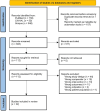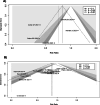Andexanet alpha versus four-factor prothrombin complex concentrate in DOACs anticoagulation reversal: an updated systematic review and meta-analysis
- PMID: 38970010
- PMCID: PMC11225147
- DOI: 10.1186/s13054-024-05014-x
Andexanet alpha versus four-factor prothrombin complex concentrate in DOACs anticoagulation reversal: an updated systematic review and meta-analysis
Abstract
Background: There is currently a lack of evidence for the comparative effectiveness of Andexanet alpha and four-factor prothrombin complex concentrate (4F-PCC) in anticoagulation reversal of direct oral anticoagulants (DOACs). The primary aim of our systematic review was to verify which drug is more effective in reducing short-term all-cause mortality. The secondary aim was to determine which of the two reverting strategies is less affected by thromboembolic events.
Methods: A systematic review and meta-analysis was performed.
Results: Twenty-two studies were analysed in the systematic review and quantitative synthesis. In all-cause short-term mortality, Andexanet alpha showed a risk ratio (RR) of 0.71(95% CI 0.37-1.34) in RCTs and PSMs, compared to 4F-PCC (I2 = 81%). Considering the retrospective studies, the pooled RR resulted in 0.84 (95% CI 0.69-1.01) for the common effects model and 0.82 (95% CI 0.63-1.07) for the random effects model (I2 = 34.2%). Regarding the incidence of thromboembolic events, for RCTs and PSMs, the common and the random effects model exhibited a RR of 1.74 (95% CI 1.09-2.77), and 1.71 (95% CI 1.01-2.89), respectively, for Andexanet alpha compared to 4F-PCC (I2 = 0%). Considering the retrospective studies, the pooled RR resulted in 1.21 (95% CI 0.87-1.69) for the common effects model and 1.18 (95% CI 0.86-1.62) for the random effects model (I2 = 0%).
Conclusion: Considering a large group of both retrospective and controlled studies, Andexanet alpha did not show a statistically significant advantage over 4F-PCC in terms of mortality. In the analysis of the controlled studies alone, Andexanet alpha is associated with an increased risk of thromboembolic events.
Clinical trial registration: PROSPERO: International prospective register of systematic reviews, 2024, CRD42024548768.
Keywords: 4F-PCC; Andexanet alpha; Anticoagulation reversal; DOACs; Haemorrhage; Meta-analysis.
© 2024. The Author(s).
Conflict of interest statement
The authors declare that they have no competing interests.
Figures






References
-
- Milioglou I, Farmakis I, Neudeker M, Hussain Z, Guha A, Giannakoulas G, Kotoula V, Papaioannou M. Prothrombin complex concentrate in major bleeding associated with DOACs; an updated systematic review and meta-analysis. J Thromb Thrombol. 2021;52(4):1137–1150. doi: 10.1007/s11239-021-02480-w. - DOI - PubMed
Publication types
MeSH terms
Substances
LinkOut - more resources
Full Text Sources
Medical

